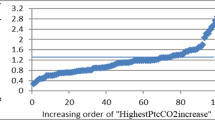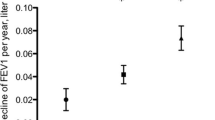Abstract
Purpose
More than half of patients with chronic obstructive pulmonary disease (COPD) experiences sleep-related problems and about one fourth uses hypnotics regularly. We explored what the effect zopiclone, a commonly used hypnotic, had on nocturnal gas exchange and the apnea/hypopnea frequency in stable COPD.
Methods
Randomized crossover study of 31 (ten males) inpatients at a pulmonary rehabilitation hospital, median age 64 years, of which 20 had a forced expiratory volume first second <50 % of predicted. Subjects investigated in randomized order of either baseline sleep or intervention with 5 mg zopiclone by polysomnography including transcutaneous measurement of carbon dioxide pressure increased (ΔPtcCO2).
Results
Zopiclone increased the mean ΔPtcCO2 from baseline both in rapid eye movement (REM) sleep, non-REM sleep, and even in stage N0 (awake after sleep onset) with a mean (SD) of 0.25 (0.40) kPa, 0.22 (0.32) kPa, and 0.14 (0.27) kPa, respectively. Subjects with sleep hypoventilation as defined by the American Academy of Sleep Medicine increased from 6 subjects (19 %) to 13 subjects (42 %) (P = 0.020). REM sleep minimum oxygen saturation (minSpO2) did not change significantly from baseline median (interquartile range [IQR]) minSpO2 81.8 (12.1) % to zopiclone sleep median (IQR) minSpO2 80.0 (12.0) % (P = 0.766). Interestingly, zopiclone reduced the number of apneas/hypopneas per hour (AHI) in subjects with overlap (AHI ≥ 15) with a median difference (IQR) of −8.5 (7.8) (N = 11, P = 0.016).
Conclusions
In stable COPD, zopiclone moderately increases the mean ΔPtcCO2 without changing minSpO2 at night and reduces AHI in overlap (COPD and obstructive sleep apnea) subjects.




Similar content being viewed by others
Notes
According to the AASM, SH is scored when there is an increase in the PaCO2 (or surrogate) ≥10 mmHg ([1.3 kPa] in comparison to an awake supine value) to a value exceeding 50 mmHg (6.7 kPa) for ≥10 min or the PaCO2 (or surrogate) >55 mmHg (7.3 kPa) for ≥10 min [18]
PICO50, Radiometer, Copenhagen, Denmark
Radiometer, Copenhagen, Denmark
Medcare Flaga, Reykjavik, Iceland
Radiometer, Basel, Switzerland
In a previous study of 100 COPD subjects [22], the mean increase (standard deviation) in PtcCO2 during spontaneous sleep was 0.49 (0.32) kPa.
References
Lozano R, Naghavi M, Foreman K, Lim S, Shibuya K et al (2012) Global and regional mortality from 235 causes of death for 20 age groups in 1990 and 2010: a systematic analysis for the Global Burden of Disease Study 2010. Lancet 380(9859):2095–2128. doi:10.1016/S0140-6736(12)61728-0
Leitch AG, Clancy LJ, Leggett RJ, Tweeddale P, Dawson P, Evans JI (1976) Arterial blood gas tensions, hydrogen ion, and electroencephalogram during sleep in patients with chronic ventilatory failure. Thorax 31(6):730–735
Fleetham J, West P, Mezon B, Conway W, Roth T, Kryger M (1982) Sleep, arousals, and oxygen desaturation in chronic obstructive pulmonary disease. The effect of oxygen therapy. Am Rev Respir Dis 126(3):429–433
Klink M, Quan SF (1987) Prevalence of reported sleep disturbances in a general adult population and their relationship to obstructive airways diseases. Chest 91(4):540–546
Celli BR, MacNee W, Task Force ATSERS (2004) Standards for the diagnosis and treatment of patients with COPD: a summary of the ATS/ERS position paper. Eur Respir J 23(6):932–946
Cormick W, Olson LG, Hensley MJ, Saunders NA (1986) Nocturnal hypoxaemia and quality of sleep in patients with chronic obstructive lung disease. Thorax 41(11):846–854
Stege G, Vos PJ, van den Elshout FJ, Richard Dekhuijzen PN, van de Ven MJ, Heijdra YF (2008) Sleep, hypnotics and chronic obstructive pulmonary disease. Respir Med 102(6):801–814. doi:10.1016/j.rmed.2007.12.026
Wadworth AN, McTavish D (1993) Zopiclone. a review of its pharmacological properties and therapeutic efficacy as an hypnotic. Drugs Aging 3(5):441–459
Krystal AD, Walsh JK, Laska E, Caron J, Amato DA, Wessel TC, Roth T (2003) Sustained efficacy of eszopiclone over 6 months of nightly treatment: results of a randomized, double-blind, placebo-controlled study in adults with chronic insomnia. Sleep 26(7):793–799
Ranlov PJ, Nielsen SP (1987) Effect of zopiclone and diazepam on ventilatory response in normal human subjects. Sleep 10(Suppl 1):40–47
Beaupre A, Soucy R, Phillips R, Bourgouin J (1988) Respiratory center output following zopiclone or diazepam administration in patients with pulmonary disease. Respiration 54(4):235–240
Tirlapur VG, Mir MA (1982) Nocturnal hypoxemia and associated electrocardiographic changes in patients with chronic obstructive airways disease. N Engl J Med 306(3):125–130. doi:10.1056/NEJM198201213060301
Shepard JW Jr, Schweitzer PK, Keller CA, Chun DS, Dolan GF (1984) Myocardial stress. Exercise versus sleep in patients with COPD. Chest 86(3):366–374
Boysen PG, Block AJ, Wynne JW, Hunt LA, Flick MR (1979) Nocturnal pulmonary hypertension in patients with chronic obstructive pulmonary disease. Chest 76(5):536–542
MacNee W (1994) Pathophysiology of cor pulmonale in chronic obstructive pulmonary disease. Part One. Am J Respir Crit Care Med 150(3):833–852. doi:10.1164/ajrccm.150.3.8087359
McNicholas WT, Fitzgerald MX (1984) Nocturnal deaths among patients with chronic bronchitis and emphysema. Br Med J (Clin Res Ed) 289(6449):878
Hatle L, Rokseth R (1974) The arterial to end-expiratory carbon dioxide tension gradient in acute pulmonary embolism and other cardiopulmonary diseases. Chest 66(4):352–357
Berry RB, Budhiraja R, Gottlieb DJ, Gozal D, Iber C, Kapur VK, Marcus CL, Mehra R, Parthasarathy S, Quan SF, Redline S, Strohl KP, Davidson Ward SL, Tangredi MM (2012) Rules for scoring respiratory events in sleep: update of the 2007 AASM Manual for the Scoring of Sleep and Associated Events. DELIBERATIONS of the Sleep Apnea Definitions Task Force of the American Academy of Sleep Medicine. JCSM : Off Publ Am Acad Sleep Med 8(5):597–619. doi:10.5664/jcsm.2172
Stege G, Heijdra YF, van den Elshout FJ, van de Ven MJ, de Bruijn PJ, van Sorge AA, Dekhuijzen PN, Vos PJ (2010) Temazepam 10 mg does not affect breathing and gas exchange in patients with severe normocapnic COPD. Respir Med 104(4):518–524. doi:10.1016/j.rmed.2009.10.022
Eckert DJ, Owens RL, Kehlmann GB, Wellman A, Rahangdale S, Yim-Yeh S, White DP, Malhotra A (2011) Eszopiclone increases the respiratory arousal threshold and lowers the apnoea/hypopnoea index in obstructive sleep apnoea patients with a low arousal threshold. Clin Sci (Lond) 120(12):505–514. doi:10.1042/CS20100588
Muir JF, DeFouilloy C, Broussier P, Locquet R, Maillard F (1990) Comparative study of the effects of zopiclone and placebo on respiratory function in patients with chronic obstructive respiratory insufficiency. Int Clin Psychopharmacol 5(Suppl 2):85–94
Holmedahl NH, Øverland B, Fondenes O, Ellingsen I, Hardie JA (2014) Sleep hypoventilation and daytime hypercapnia in stable chronic obstructive pulmonary disease. Int J of COPD 9:265–275
Global Initiative for Chronic Obstructive Lung Disease (GOLD) (2014) Global strategy for the diagnosis, management and prevention of COPD. Updated Jan 2014. Available from: http://www.goldcopd.org/.Date last accessed: June 13 2014
Quanjer PH, Tammeling GJ, Cotes JE, Pedersen OF, Peslin R, Yernault JC (1993) Lung volumes and forced ventilatory flows. Report working party standardization of lung function tests, european community for steel and coal. Official statement of the european respiratory society. Eur Respir J Suppl 16:5–40
Iber C, Ancoli-Israel S, Chesson AL, Quan SF, (ed) for the American Academy of Sleep Medicine (2007) The AASM manual for the scoring of sleep and associated events. Rules, terminology and technical specifications, Westchester
Birchfield RI, Sieker HO, Heyman A (1958) Alterations in blood gases during natural sleep and narcolepsy; a correlation with the electroencephalographic stages of sleep. Neurology 8(2):107–112
Bristow JD, Honour AJ, Pickering TG, Sleight P (1969) Cardiovascular and respiratory changes during sleep in normal and hypertensive subjects. Cardiovasc Res 3(4):476–485
The Report of an American Academy of Sleep Medicine Task Force (1999) Sleep-related breathing disorders in adults: recommendations for syndrome definition and measurement techniques in clinical research. Sleep 22(5):667–689
Quan SF, Griswold ME, Iber C, Nieto FJ, Rapoport DM, Redline S, Sanders M, Young T, Sleep Heart Health Study Research G (2002) Short-term variability of respiration and sleep during unattended nonlaboratory polysomnography—the Sleep Heart Health Study. Sleep 25(8):843–849
Ahmadi N, Shapiro GK, Chung SA, Shapiro CM (2009) Clinical diagnosis of sleep apnea based on single night of polysomnography vs. two nights of polysomnography. Sleep Breath 13(3):221–226. doi:10.1007/s11325-008-0234-2
Acknowledgments
PSG hardware and software were provided by ResMed, Norway. The authors wish to thank the staff at Glittreklinikken for the enthusiastic support and participation in the data collection. Financial support was received from the Norwegian ExtraFoundation for Health and Rehabilitation, LHL’s Research fund, Glittreklinikken, and the Norwegian National Centre of Excellence in Home Mechanical Ventilation. Minor grants were received from the Norwegian Lung Medicine Society/Takeda Nycomed, Major Eckbo’s endowments, and the University of Bergen.
Author information
Authors and Affiliations
Corresponding author
Rights and permissions
About this article
Cite this article
Holmedahl, N.H., Øverland, B., Fondenes, O. et al. Zopiclone effects on breathing at sleep in stable chronic obstructive pulmonary disease. Sleep Breath 19, 921–930 (2015). https://doi.org/10.1007/s11325-014-1084-8
Received:
Revised:
Accepted:
Published:
Issue Date:
DOI: https://doi.org/10.1007/s11325-014-1084-8




